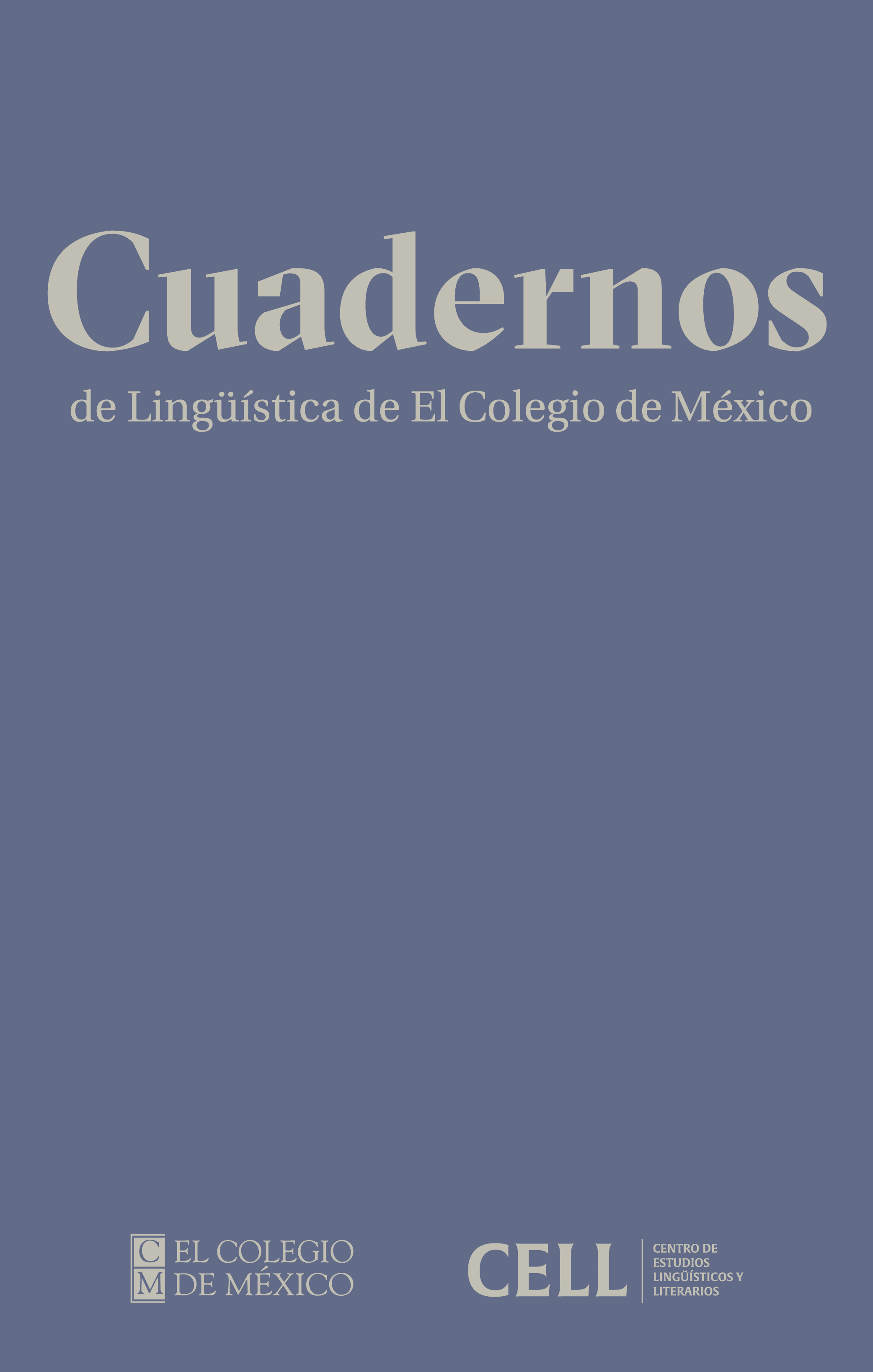La posición de los marcadores del Juego B en el proto-maya
DOI:
https://doi.org/10.24201/clecm.v10i00.278Palabras clave:
proto-maya, cambio lingüístico, lingüística histórica, pronombres de juego B, enclíticos de segunda posiciónResumen
En este artículo se discute la posición de los pronombres del Juego B en el proto-maya. Mientras que reconstrucciones anteriores se distinguen respecto a la posición exacta que los pronombres del Juego B ocupaban con relación al predicado (siempre precediendo, siempre siguiendo o a veces precediendo y a veces siguiendo el predicado), todas las reconstrucciones asumen que se agregaban al predicado, de igual manera que suelen hacerlo en las lenguas mayas contemporáneas. Basándose en casos en las lenguas mayas contemporáneas y coloniales donde los pronombres del Juego B o se agregan a un no-predicado en vez del predicado o al predicado falso, en este artículo se propone que en proto-maya los pronombres del Juego B eran enclíticos de segunda posición (últimamente derivados de pronombres personales independientes) que independientemente de la clase de palabras del anfitrión se agregaban a la primera palabra de la oración. Que en las lenguas mayascontemporáneas los pronombres del Juego B se agregan al predicado es una innovación que resulta del hecho de que los verbos suelen posicionarse en el inicio de la oración en las lenguas mayas.
Descargas
Citas
Adell, Eric James. 2019. The phonetics, phonology, and morphology of Chajul Ixil (Mayan). Austin: The University of Texas. (PhD dissertation.) http://dx.doi.org/10.26153/tsw/5463
Ayres, Glenn. 1991. La gramatica Ixil. Guatemala: Centro de Investigaciones Regionales de Mesoamérica.
Barrett, Edward Rush. 1999. A grammar of Sipakapense Maya. Austin:The University of Texas. (PhD dissertation.)
Bricker, Victoria Reifler. 1977. Pronominal inflection in the Mayan languages. New Orleans: Middle American Research Institute. https://search.lib.uiowa.edu/permalink/f/r4nrvn/01IOWA_ALMA21430739150002771
Bricker, Victoria R. 2019. A historical grammar of the Maya language of Yucatan: 1557-2000. Salt Lake City: The University of Utah Press. https://uofupress.lib.utah.edu/a-historical-grammar-of-the-mayalanguage-of-yucatan-1557-2000/ DOI: https://doi.org/10.1353/book65932
Brown, Linda Kay. 1979. Word formation in Pocomchi (Mayan). Stanford: Stanford University. (PhD dissertation.)
Campbell, Lyle. 1979. Review of Victoria Reifler Bricker. 1977. Pronominal inflection in the Mayan languages. American Anthropologist 81. 976. https://doi.org/10.1525/aa.1979.81.4.02a00770 DOI: https://doi.org/10.1525/aa.1979.81.4.02a00770
Campbell, Lyle. 1988. The linguistics of southeast Chiapas, Mexico. Provo: Brigham Young University. https://contentdm.lib.byu.edu/digital/collection/NWAF/id/2749/
Campbell, Lyle & Kaufman, Terrence. 1985. Mayan linguistics: where are we now? Annual Review of Anthropology 14. 187-198. https://www.jstor.org/stable/2155594 DOI: https://doi.org/10.1146/annurev.an.14.100185.001155
Can Pixabaj, Telma Angelina. 2007. Jkemiik yoloj li Uspanteko. Gramática uspanteka. Guatemala: OKMA.
Can Pixabaj, Telma A. 2017. K’iche’. In Aissen, Judith; England, Nora C. & Zavala Maldonado, Roberto (eds.), The Mayan languages, 461-499. London / New York: Routledge. https://doi.org/10.4324/9781315192345 DOI: https://doi.org/10.4324/9781315192345-18
Coon, Jessica; Mateo Pedro, Pedro & Preminger, Omer. 2014. The role of case in A-bar extraction asymmetries; evidence from Mayan. Linguistic Variation 14(2). 179-242. https://doi.org/10.1075/lv.14.2.01coo DOI: https://doi.org/10.1075/lv.14.2.01coo
Day, Christopher. 1973. The Jacaltec language. Bloomington: Indiana University. DOI: https://doi.org/10.1515/9783110891904
Dayley, Jon P. 1981. Tzutujil grammar. Berkeley: University of California. (PhD dissertation.) https://escholarship.org/uc/item/4cx9t9b1
DuBois, John William. 1981. The Sacapultec language. Berkeley: University of California. (PhD dissertation.) https://escholarship.org/uc/item/9rw0b3ct
Dürr, Michael. 2003. Morphologie, Syntax und Textstrukturen des (Maya-)Quiche des Popol Vuh; Linguistische Beschreibung eines kolonialzeitlichen Dokuments aus dem Hochland von Guatemala. Berlin:self-publishing.
Edmonson, Barbara. 1987. Huastec pronouns in Mayan Languages and their speakers. Anthropological Linguistics 29(4). 342-361. https://www.jstor.org/stable/30028109
Edmonson, Barbara Wedemeyer. 1988. A descriptive grammar of Huastec (Potosino dialect). New Orleans: Tulane University. (PhD dissertation.)
England, Nora C. 1983. A grammar of Mam, a Mayan language. Austin: University of Texas Press. DOI: https://doi.org/10.7560/727267
England, Nora C. 1991. Changes in basic word order in Mayan languages. International Journal of American Linguistics 57(4). 446-486. https://www.jstor.org/stable/3519735 DOI: https://doi.org/10.1086/ijal.57.4.3519735
Frank, Vernon. 1976. The Proto-Mayan verb phrase. Arlington: University of Texas at Arlington. (MA thesis.) https://www.sil.org/resources/archives/9624
García Matzar, Pedro (Lolmay) & Rodríguez Guaján, José Obispo (Pakal B’alam). 2001. Rukemik ri Kaqchikel Chi’. Gramática Kaqchikel. Guatemala:Cholsamaj.
Hober, Nicole. 2022. Grammaticalization and variation. The case of Mayan motion verbs. Berlin / Boston: de Gruyter. https://doi.org/10.1515/9783110728613 DOI: https://doi.org/10.1515/9783110728613
Hofling, Charles Andrew. 2006. A sketch of the history of the verbal complex in Yukatekan Mayan languages. International Journal of American Linguistics 72(3). 367-396. https://doi.org/10.1086/509490 DOI: https://doi.org/10.1086/509490
Hofling, Charles Andrew. 2018. Cambio diacrónico en la familia lingüística yucatecana. Cuadernos de Lingüística de El Colegio de México 5(1). 6-46. https://doi.org/10.24201/clecm.v5i1.95 DOI: https://doi.org/10.24201/clecm.v5i1.95
Holtmann, Thilo Momme. 2022. On agent focus agreement in Proto-Mayan. LIAMES: Línguas Indígenas Americanas 22. 1–15. https://doi.org/10.20396/liames.v22i00.8670032 DOI: https://doi.org/10.20396/liames.v22i00.8670032
Houston, Stephen; Robertson, John & Stuart, David. 2000. The language of Classic Maya inscriptions. Current Anthropology 41(3). 321–356. https://doi.org/10.1086/300142 DOI: https://doi.org/10.1086/300142
Hopkins, Nicholas Arthur. 1967. The Chuj language. Chicago: University of Chicago. (PhD dissertation.) https://www.academia.edu/43664342/The_Chuj_Language_1967_revised_2012_
Hopper, Paul J. & Traugott, Elizabeth Closs. 2003. Grammaticalization. 2nd edition. Cambridge: Cambridge University Press. https://doi.org/10.1017/CBO9781139165525 DOI: https://doi.org/10.1017/CBO9781139165525
Kaufman, Terrence. 1969. Teco: a new Mayan language. International Journal of American Linguistics 35(2). 154-174. https://www.jstor.org/stable/i254086 DOI: https://doi.org/10.1086/465050
Kaufman, Terrence. 1972. El proto-tzeltal-tzotzil. Fonología comparada y diccionario reconstruido. Mexico: Universidad Nacional Autónoma de México. https://www.iifilologicas.unam.mx/chiifl9/doku.php/el_proto-tzeltal-tzotzil_1972
Kaufman, Terrence. 1976. Archaeological and linguistic correlations in Mayaland and associated areas of Meso-America. World Archaeology 8(1). 101–118. https://doi.org/10.1080/00438243.1976.9979655 DOI: https://doi.org/10.1080/00438243.1976.9979655
Kaufman, Terrence. 2015. Mayan comparative studies. Manuscript. https://www.albany.edu/ims/Kaufman-Mayan%20Comparative%20Studies.pdf
Kaufman, Terrence S. & Norman, William M. 1984. An outline of Proto-Cholan phonology, morphology and vocabulary. In Justeson, John
S. & Campbell, Lyle (eds.), Phoneticism in Mayan hieroglyphic writing, 77–166. Albany / New York: Institute for Mesoamerican Studies.
Kondić, Snježana. 2012. A grammar of South Eastern Huastec, a Mayan language from Mexico. Sydney / Lyon: University of Sydney / Université Lyon. (PhD dissertation.) https://hdl.handle.net/2123/29258
Larsen, Thomas W. 1983. Aguacatec syntax from a functional perspective. In Schlichter, Alice; Chafe, Wallace L. & Hinton, Leane (eds.), Studies in Mesoamerican linguistics, 120–219. Berkeley: Survey of California and Other Indian Languages. https://escholarship.org/uc/item/3mh3411v
Law, Danny. 2020. Contact and Mayan languages. In Hickey, Raymond (ed.), The handbook of language contact, 613–623. 2nd edition. John Wiley and Sons Ltd. https://doi.org/10.1002/9781119485094.ch31 DOI: https://doi.org/10.1002/9781119485094.ch31
Law, Danny; Houston, Stephen; Carter, Nicholas; Zender, Marc & Stuart, David. 2014. Reading in context: the interpretation of personal
reference in ancient Maya hieroglyphic texts. Journal of Linguistic Anthropology 23(2). 23–47. http://doi.org/10.1111/jola.12008 DOI: https://doi.org/10.1111/jola.12008
Law, Danny & Stuart, David. 2017. Classic Mayan; an overview of language in ancient hieroglyphic script. In Aissen, Judith; England, Nora C. & Zavala Maldonado, Roberto (eds.), The Mayan Languages, 128–172. London / New York: Routledge. DOI: https://doi.org/10.4324/9781315192345-6
Lehmann, Christian. 2020. Grammaticalization in Yucatec Maya. In Bisang, Walter & Malchukov, Andrej (eds.), Grammaticalization Scenarios: Cross-linguistic Variation and Universal Tendencies; Volume 2: Grammaticalization Scenarios from Africa, the Americas, and the Pacific, 803–852. Berlin / Boston: de Gruyter. DOI: https://doi.org/10.1515/9783110712735-005
Mateo Toledo, Eladio. 2017. Q’anjob’al. In Aissen, Judith; England, Nora C. & Zavala Maldonado, Roberto (eds.), The Mayan languages, 533–569. London / New York: Routledge.
Newmeyer, Frederick J. 1998. Language form and language function. Cambridge (Massachusetts) / London: Massachusetts Institute of DOI: https://doi.org/10.7551/mitpress/4115.001.0001
Technology.
Norde, Muriel. 2009. Degrammaticalization. Oxford: Oxford University Press. DOI: https://doi.org/10.1093/acprof:oso/9780199207923.001.0001
Norman, William M. & Campbell, Lyle. 1978. Toward a Proto-Mayan syntax: a comparative perspective on grammar. In England, Nora C.
(ed.), Papers in Mayan linguistics, 136–156. Columbia: University of Missouri.
Osborne, Deborah Joanne. 1989. Towards the reconstruction of the root morphemes of the pronominal affixes of Proto-Mayan. Burnaby: Simon Fraser University. (PhD dissertation.)
Palosaari, Naomi Elizabeth. 2011. Topics in Mocho’ phonology and morphology. Salt Lake City: The University of Utah. (PhD dissertation.)
Polian, Gilles. 2013. Gramática del tseltal de Oxchuc. Mexico: Centro de Investigaciones y Estudios Superiores en Antropología Social.
Polian, Gilles. 2017. Tseltal and Tsotsil. In Aissen, Judith; England, Nora C. & Zavala Maldonado, Roberto (eds.), The Mayan languages, 610–647. London / New York: Routledge. DOI: https://doi.org/10.4324/9781315192345-22
Pye, Clifton. 2009. Cycles of complementation in the Mayan languages. In van Gelderen, Elly (ed.), Cyclical change, 265-284. Amsterdam: John Benjamins. https://doi.org/10.1075/la.146.15pye DOI: https://doi.org/10.1075/la.146.15pye
Quizar, Stephanie (Robin). 1979. Comparative word order in Mayan. Boulder: University of Colorado at Boulder. (PhD dissertation.)
Ramírez del Prado, Alejandro Curiel. 2017. Tojolabal. In Aissen, Judith; England, Nora C. & Zavala Maldonado, Roberto (eds.), The Mayan DOI: https://doi.org/10.4324/9781315192345-21
languages, 570–609. London / New York: Routledge. https://doi.org/10.4324/9781315192345 DOI: https://doi.org/10.4324/9781315192345
Robertson, John S. 1980. The structure of pronoun incorporation in the Mayan verbal complex. New York / London: Garland Publishing.
Robertson, John S. 1992. The history of tense / aspect / mood / voice in the Mayan verbal complex. Austin: University of Texas Press. DOI: https://doi.org/10.7560/720756
Royer, Justin; Mateo Pedro, Pedro; Carolan, Elizabeth; Coon, Jessica & Torres, Matal. 2022. Atz’am k’ik’ atz’am: the story of Xuwan and a
grammatical sketch of Chuj. Tlalocan 27. 215-286. https://revistas-filologicas.unam.mx/tlalocan/index.php/tl/article/view/556
Schweitzer, Jürgen. 2006. Das Grosse im Kleinen. Zur diachronen Typologie des Maya-Verbalkomplexes unter besonderer Berücksichtigung des ch’olotzeltalischen Zweiges. Munich: Ludwig-Maximilians-Universität. (PhD dissertation.)
Siewierska, Anna. 2004. Person. Cambridge: Cambridge University Press. DOI: https://doi.org/10.1017/CBO9780511812729
Smith-Stark, Thomas Cedric. 1983. Jilotepequeño Pocomam phonology and morphology. Chicago: The University of Chicago. (PhD dissertation.)
Spencer, Andrew & Luís, Ana R. 2012. Clitics; an introduction. Cambridge: Cambridge University Press.
Stewart, Stephen O. 2015. Q’eqchi’ grammar. Lafayette: SOS Publishing.
Sychev, Roman V. 2021. Morphosyntactic features of progressive in the K’iche’an languages of the Mayan family. Open Linguistics 7. 594–612. https://doi.org/10.1515/opli-2020-0176 DOI: https://doi.org/10.1515/opli-2020-0176
Tada, Hiroaki. 1993. A / A-bar partition in derivation. Cambridge: Massachusetts Institute of Technology. (PhD dissertation.) http://dspace.mit.edu/handle/1721.1/12677
Vázquez Álvarez, Juan Jesús. 2011. A grammar of Chol, a Mayan language. Austin: The University of Texas at Austin. (PhD dissertation.) http://hdl.handle.net/2152/ETD-UT-2011-08-4293
Vinogradov, Igor. 2017a. From enclitic to prefix: diachrony of personal absolutive markers in Q’eqchi’. Morphology 27. 105-122. https://doi.org/10.1007/s11525-016-9293-4 DOI: https://doi.org/10.1007/s11525-016-9293-4
Vinogradov, Igor. 2017b. El Arte de Lengua Cacchí para Bien comun y los estudios diacrónicos de la gramática q’eqchi’. Estudios de Cultura Maya 49. 201-225. https://doi.org/10.19130/iifl.ecm.2017.49.770 DOI: https://doi.org/10.19130/iifl.ecm.2017.49.770
Vinogradov, Igor. 2018. Los sistemas de tiempo/ aspecto/ modo yucatecanos y cholanos: semejanzas y diferencias. Cuadernos de Lingüística de El Colegio de México 5(1). 148-182. https://doi.org/10.24201/clecm.v5i1.98 DOI: https://doi.org/10.24201/clecm.v5i1.98
Zavala Maldonado, Roberto. 1994. Inverse alignment in Huastec. Funcion (15–16). 27–81.
Zavala Maldonado, Roberto. 1997. Functional analysis of Akatek voice constructions. International Journal of American Linguistics 63(4). DOI: https://doi.org/10.1086/466340
–474.
Publicado
Cómo citar
-
Resumen1035
-
PDF219
-
XML23
-
EPUB58
-
Kindle110
-
MP312
Número
Sección
Licencia
Derechos de autor 2023 Momme Holtmann

Esta obra está bajo una licencia internacional Creative Commons Atribución-NoComercial-SinDerivadas 4.0.
Los autores conservan los derechos sobre su obra y tienen libertad de diseminar su trabajo y hacerlo disponible en otros lugares (repositorios, páginas web personales, antologías), pero garantizarán a esta revista el derecho de primera publicación y se comprometen a citar CLECM como referencia de la publicación original.
Los trabajos publicados en Cuadernos de Lingüística de El Colegio de México se publican bajo los términos que se indican en la Licencia Creative Commons con Atribución-NoComercial-SinDerivadas 4.0 Internacional.








